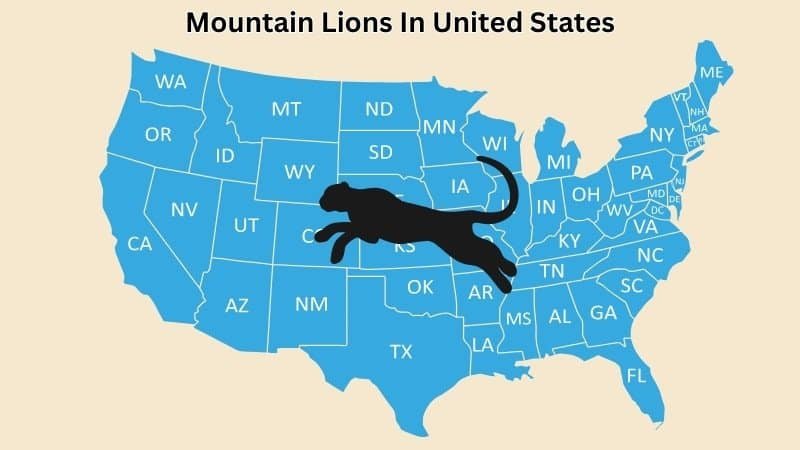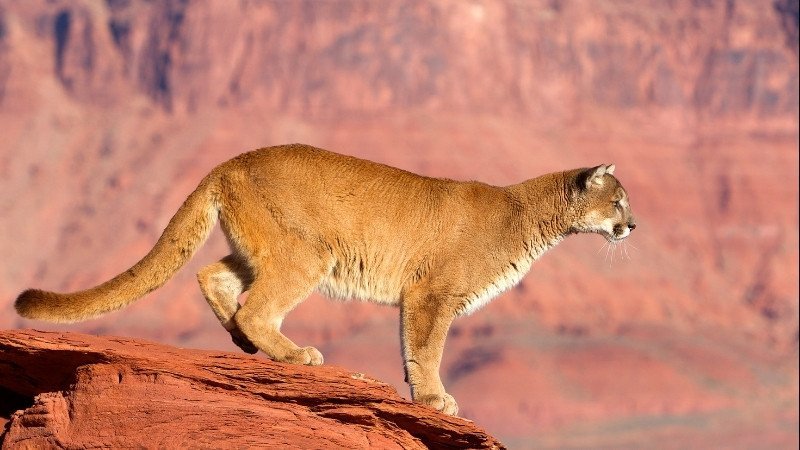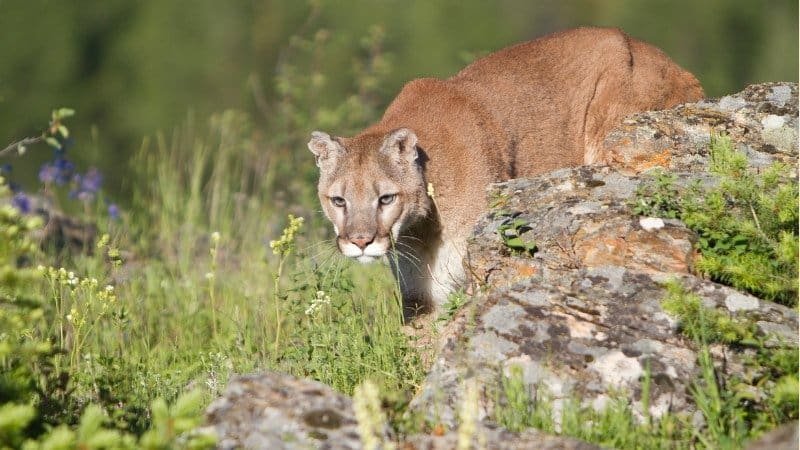
You may have heard of lions living in Africa and Asia, but are there any Mountain lion in United States? The mountain lion, also known as the puma, panther, catamount, or cougar, is a wild cat native to the Americas. They are large cats that, surprisingly enough, cannot roar.
Instead, they communicate through growls, purrs, hisses, and shrieks. Their tan, slender bodies can be seen stealthily moving across mountains, forests, deserts, and even swamps.
Are There Mountain Lions In The United States?
Yes, the United States is home to mountain lions! These highly adaptable animals have the largest territorial range of any land mammal, other than humans. They live in both North America and South America- right from Canada all the way south to Chile.
Cougars have been roaming the Americas for thousands and thousands of years. The species was so widespread that they had multiple subspecies, depending on their location. Some of these included the North American cougar, the Costa Rican cougar, and the Eastern cougar.
Here’s a complete breakdown of mountain lion distribution in the US:
- Western US: Mountain lions are common in the Rocky Mountains, Sierra Nevada, Cascade Range, and Great Basin. States with confirmed breeding populations include Arizona, California, Colorado, Idaho, Montana, Nevada, New Mexico, Oregon, South Dakota, Utah, Washington, Wyoming.
- Florida: The Florida panther is a critically endangered subspecies of mountain lion found in the southern part of the state.
- Eastern US: Mountain lions were extirpated from the eastern US in the early 20th century, but there have been unconfirmed sightings in recent years. Some experts believe they may be slowly recolonizing their former range.
How Many Mountain Lions Live In The United States?
Currently, the estimated population of mountain lions in the United States is between 20,000 and 40,000 individuals. This number is a rough estimate because cougars are sneaky and difficult to track. Most of them live in isolated, uninhabited regions.
The cougar population in the States used to be much higher. The wild cats were so widely distributed, that their numbers probably touched the millions. However, things took a turn for them when humans came into the picture.
Throughout the 19th and 20th centuries, cougars were viewed as nuisance animals. Across the country, they were hunted for their fur and for bounties. They were killed by landowners who viewed them as threats to livestock and property. Their population decreased drastically and even disappeared from many eastern and central states. The western states have managed to have a stable population, thanks to various conversation efforts. Even then, the current numbers are far from what they once were.
What States In The US have Mountain Lions?
Historically, mountain lions lived in every part of the US. Their current state of affairs is much different. Only 17 states in the US have a native mountain lion population- most of which lie in the west.
Other states may see some from time to time, but they’re almost always cats who have just come for a visit.
Colorado boasts the highest known population of cougars, with numbers that could reach 7,000. This is due to Colorado’s array of landscapes and its abundance of deer. Arkansas is believed to have the smallest population of these felines, with around 20-30 of them. Florida is the only state with the Florida Panther, an east-American subspecies.
Here are the estimated populations of mountain lions in each of the 17 states:
| No. | State | Estimated Mountain Lion Population |
| 1. | Arizona | 2,000-2,700 |
| 2. | Arkansas | 20-30 |
| 3. | California | 4,000-6,000 |
| 4. | Colorado | 4,000-7,000 |
| 5. | Florida | 120-230 |
| 6. | Idaho | 2,000 |
| 7. | Montana | 4,000-4,500 |
| 8. | Nebraska | 30-50 |
| 9. | Nevada | 2,000 |
| 10. | New Mexico | 3,500-4,200 |
| 11. | North Dakota | 25-50 |
| 12. | Oregon | 6,000-6,400 |
| 13. | South Dakota | 300-500 |
| 14. | Texas | Unknown. Few hundred confirmed |
| 15. | Utah | 2,500 |
| 16. | Washington | 1,500 |
| 17. | Wyoming | 2,000 |
Many other states like Michigan, Kansas, and Illinois have confirmed sightings. Experts believe that the mountain lion is slowly re-expanding its range.
How Common Are Mountain Lions In United States?

Mountain lions are solitary animals. They hunt alone, eat alone, and roam alone. They are extremely territorial and can have individual territories of up to 150 square miles. They also prefer to live far away from humans and other predators. While they are found in virtually every type of habitat, they choose areas that are rather inaccessible to humans.
So, while there are a large number of cougars in certain states, they aren’t quite common to encounter.
Commonality Of Mountain Lion State-Specific Populations:
- Western US: This region hosts the majority of mountain lions, with some states harboring substantial populations:
- Colorado: With an estimated 7,000 individuals, Colorado boasts the highest known mountain lion population in the US.
- California: California’s diverse terrain provides suitable habitat for a significant population of these big cats.
- Arizona: Mountain lions thrive in Arizona’s varied landscapes, including mountains, forests, and deserts.
- Idaho, Montana, Nevada, New Mexico, Oregon, Utah, Washington, and Wyoming: These states also support healthy mountain lion populations due to their suitable habitat.
- Eastern US: Mountain lions were extirpated from the eastern US in the early 20th century, but there have been unconfirmed sightings in recent years, suggesting potential recolonization efforts.
- Florida: The Florida panther, a critically endangered subspecies of mountain lion, resides in the southern part of the state, primarily in the Everglades region.
Commonality by Region:
Western US: Mountain lions are quite common in the Rocky Mountains, Sierra Nevada, Cascade Range, and Great Basin. Hikers and campers in these areas should stay alert and take precautions.
Eastern US: Mountain lions are not considered common in the eastern US due to their historical disappearance. If you notice signs like tracks or large cat prints, report them to wildlife authorities.
Florida: The critically endangered Florida panther is exceptionally uncommon. Spotting one in the wild would be a very rare occurrence. If you’re in Florida and come across one, consider it a unique and precious sighting.
What Do Mountain Lions Eat In The United States?
Mountain lions are hunters with many tricks up their sleeves. They hunt at night and use ambush tactics to kill their prey. They quietly stalk their prey and launch a surprise attack from behind. Once they’re finished eating, they bury the leftover carcass under soil, to keep it safe from other animals.
Mountain lions in the US mostly eat deer, specifically whitetail deer and mule tail deer. In times of deer shortage, they also eat animals like rabbits, turkeys, bighorn sheep, raccoons, and smaller rodents. They are even known to eat porcupines- spines and all!
Here’s a glimpse into what mountain lions typically eat in the US, main course, smaller plates, rare treats:
| Main Course | Prey | Description |
|---|---|---|
| Deer | Mule deer, white-tailed deer | Mountain lions’ favorite, constituting the bulk of their diet. Agile cats can take down prey much larger than themselves. |
| Elk | Elk | Majestic herbivores in areas with abundant elk populations. Larger size requires more effort to bring down, but the reward is substantial. |
| Bighorn sheep | Bighorn sheep | Impressive mountain dwellers adding variety to the diet. Surefootedness on rocky terrain can pose a challenge, but skilled lions can manage. |
| Smaller Plates | Prey | Description |
| Rabbits and hares | Rabbits, hares | Smaller mammals providing quick and easy meals, especially when larger prey are scarce. |
| Rodents | Mice, rats, other rodents | Not particularly filling but contribute to the overall diversity of the diet. Essential during lean times. |
| Raccoons and opossums | Raccoons, opossums | Occasional prey offering a different flavor profile compared to the usual herbivore fare. |
| Coyotes | Coyotes | Competitors turned prey, particularly for younger cats honing their hunting skills. |
| Rare Treats | Prey | Description |
| Wild pigs | Feral hogs | Opportunistic eaters in areas with feral hog populations. Might find themselves on the menu for a hungry mountain lion. |
| Birds | Turkeys, large birds | Occasionally snagged, adding avian variety to the diet. Not a primary focus but showcases adaptability. |
| Fish | Fish | Some mountain lions observed catching fish, displaying adaptability and resourcefulness. |
How Big Are Mountain Lions In The United States?

Mountain lions can look really big and scary up close, and that’s because they are! These cats are the second largest cats in all of America.
Overall Size:
- Length: Adult mountain lions typically range from 6 to 8 feet long (1.8 to 2.4 meters), from nose to tail, with males generally being larger than females.
- Height: At the shoulder, these big cats stand around 2 to 3 feet tall (0.6 to 0.9 meters).
- Weight: The weight range for mountain lions in the US is quite broad, spanning from 64 to 220 pounds (29 to 100 kilograms). Males, again, tend to be heavier than females, with an average weight around 140-180 pounds (64-82 kg) compared to females at 80-130 pounds (36-59 kg).
Size Differences by Sex:
- Males: As mentioned, male mountain lions are generally larger and heavier than females. They can easily reach lengths of 8 feet and weigh up to 220 pounds, making them truly formidable predators.
- Females: Females, though still sizeable, are noticeably smaller than males. They typically range from 6 to 7 feet in length and weigh between 80 and 130 pounds.
Size Variations by Habitat:
- Western US: Mountain lions in the western states, where their primary prey consists of larger deer and elk, tend to be on the larger side of the spectrum.
- Florida: The Florida panther, a critically endangered subspecies of mountain lion, is generally smaller than its western counterparts due to a different prey base focused on smaller animals like rabbits and raccoons.
Can You Own A Mountain Lion In The US?
No, you cannot legally own a mountain lion as a pet in the United States. Owning a mountain lion falls under the category of exotic pet ownership, which is highly regulated and often prohibited in most states. Here’s why you cannot own a mountain lion as a pet in the US:
Federal Regulations:
- Big Cat Public Safety Act: Picture this: in December 2022, the Big Cat Public Safety Act became a superhero law, saying a big “No” to owning or breeding big cats, even mountain lions. No permits or past ownership can get around this law.
- Lacey Act: Think of the Lacey Act as the guardian of wildlife travel. It says, “Hold up!” to mountain lions moving across states unless there’s a permit. It’s like a double-check to make sure everyone’s following the rules.
State Regulations:
- Imagine this: 21 states in the US are saying “No way” to having big cats like mountain lions as pets. These states get it – keeping powerful wild animals as roommates is a bad idea.
- Some states allow permits for certain pets, but guess what? Mountain lions are VIPs on the no-permit list. Why? Because having a mountain lion in your living room doesn’t really mix well with domestic vibes.
- Even in states with laid-back pet laws, mountain lions are usually in the “Nope, not happening” category. Why? Because having a mountain lion in your living room doesn’t really mix well with domestic vibes.
Safety Concerns:
- Let’s talk safety. Imagine your house with a mountain lion – wild instincts, predatory behaviors, the whole shebang. Not the coziest roommate, right?
- These wild creatures need special care and a specific home setup. Most folks can’t swing that, leading to problems. Imagine a mountain lion feeling like a fish out of water – not a pretty sight.
- Escapes? That’s not just a “whoopsie-daisy.” It’s a full-blown alarm. Escaped mountain lions are like unexpected guests at a party, but scarier – posing serious threats to the neighborhood and the local wildlife.
Ethical Considerations:
- Now, let’s get real about ethics. Imagine being stuck in a place that’s not your jam. That’s how mountain lions feel in homes. They deserve the wild, not a cramped apartment.
- Keeping wild creatures as pets might sound cool, but it’s like asking a mountain lion to trade its freedom for a cage. Not cool.
- Supporting pet ownership? That’s like giving a high-five to the illegal wildlife trade. It’s not just about mountain lions; it’s about all those incredible creatures facing danger because of this trade. Let’s keep the wild where it belongs – wild.
Mountain Lion Attacks In The U.S. Per Year
Unless you live in a mountain lion area, you needn’t worry too much about attacks. In fact, even in cougar-populated areas, attacks are very rare. This is because mountain lions don’t think of humans as prey.
In fact, research has shown that they’re quite scared of humans (based on their history with us, we can’t really blame them). There are many safety precautions you can follow to prevent mountain lion encounters, such as keeping your pets on a leash at all times.
In the past 100 years, there have been around 120 mountain lion attacks. On average, that’s around 1.2 attacks per year. Out of these attacks, only a few dozen were unfortunately fatal for humans. Statistics show that more mountain lions are killed by humans per year, than the other way around.
What Other Big Cats Live In The United States?
Mountain lions aren’t the only wild American cats! The US is home to 5 other cat species, which are jaguars, bobcats, Canada lynx, ocelots, and jaguarundis. Of these cats, only the jaguar is considered to be a “big cat,” and the others are classified as wild cats.
Bobcats are mid-sized cats that are found throughout the United States. They are the most common wild cats, with an estimated population of 2.5-3.5 million. It’s a member of the Lynx genus, like the Canadian lynx, and therefore shares many similarities. They are named after the “bobbed” appearance of their tails. Their coat is spotted and is usually orange-red or grayish.
Jaguars are the largest cat species in the United States, as well as the rest of the continent. They’re mainly found in the Amazonian rainforests but occasionally make their way up to Arizona, Texas, and New Mexico. These sleek cats not only lend their name to a sleek car but are infamous for their camouflaging skills.
Canada lynx are found in Alaska, Canada, and the cold northern states of the US. Since they mostly live in snowy areas, their paws have adapted to help them move more easily. They have thick gray-brown fur and tufted ears.
The ocelot is another mid-sized cat that’s mainly found in Arizona and Texas. They prefer warm, tropical climates like rainforests and marshes. They are excellent tree climbers, and unlike house cats, aren’t scared to climb down. They have pale yellow-golden fur and are often called “mini jaguars.”
Jaguarundis are native to Central and South America. A few of them have been occasionally spotted in Florida and Texas. They are the smallest wild cats found in North America- standing only a few inches taller than the average house cat. They have a long body with short legs and a short head. They either have gray or dark red coats.
All of these cats are nocturnal, apex predators. At the top of their respective food chains, they are responsible for regulating the deer and rabbit populations in their territories.
Conclusion
And that was everything about the Mountain lions in the US. I hope this article answers all your questions.
Our Sources And References
- Main Sources:
- Mountain Lion Foundation: https://mountainlion.org/
- National Wildlife Federation: https://blog.nwf.org/2013/10/were-not-mountain-lion-about-these-facts/
- Cougar – Wikipedia: https://en.wikipedia.org/wiki/Cougar
- A-Z Animals: https://www.arizona-leisure.com/mountain-lions.html
- Big Cat Public Safety Act: https://www.congress.gov/bill/117th-congress/house-bill/263
- Lacey Act: https://www.law.cornell.edu/uscode/text/16/3371

